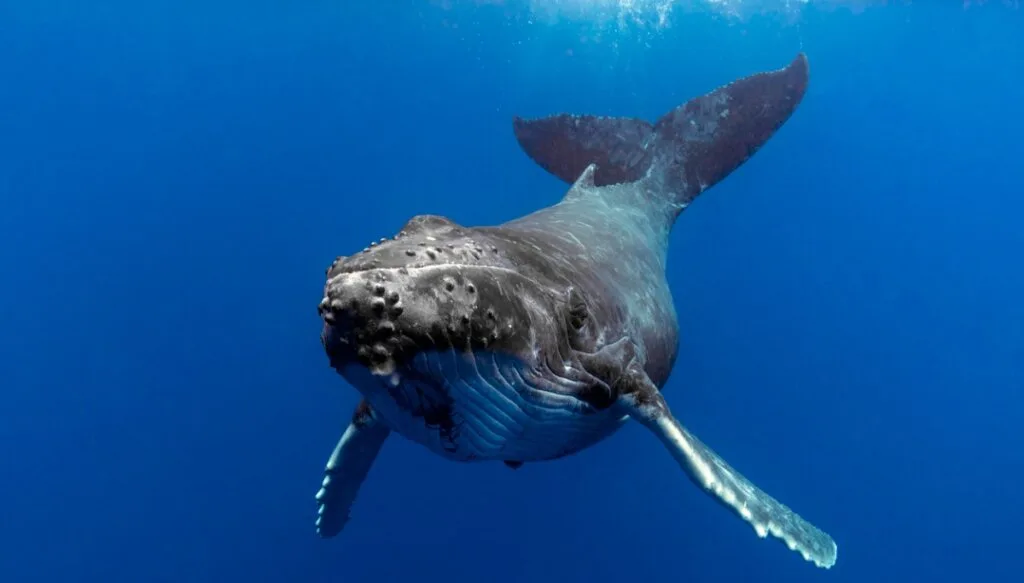Always considered the giants of the sea, whales are mysterious animals, protagonists of tales and legends. What also undoubtedly makes them fascinating is their way of communicating, an incredible and very musical song. A melody similar to that composed by humans that scientists compare to that of classical and jazz music
Whales reproduce their song when they swim underwater; in fact, the sound propagates faster in the water than in the air, and in this way the cetaceans are able to communicate with their fellows even at particularly great distances. It seems that these large mammals are even able to improvise short “phrases” composed of individual sounds called “units.” The phrases are then repeated several times to create a “theme.” Finally, the themes are sung in a coherent order without repetition, creating a true song. In particular, humpback whales- cetaceans that can reach a length of 15 meters and a weight of 30 tons-are famous for the sounds and songs they emit mainly during migration, at mating time and beyond. Songs that last up to 20 minutes, composed of numerous acoustic elements, so much so that they are considered one of the most complex forms of animal communication. As well as other sounds of nature, the vibrations and tones of whale song also have a surprising variety of positive effects on people such as promoting relaxation, sleep and quiet.
Why whales sing
The first researcher to discover whale song was Roger Searle Payne, an American biologist and conservationist, who in 1967 conducted research on cetaceans, particularly humpback and blue whales, to study their migrations, cultures and especially vocalizations. “Exuberant, uninterrupted rivers of sound” was how he described the songs of these beautiful mammals that he believed were produced to communicate across the entire ocean, a theory that was later confirmed.
Some of Searle Payne’s recordings were released in 1970 with an album called Songs of the Humpback Whale (still the best-selling natural sounds record of all time ) that helped gain visibility for the Save the Whales movement that sought to end commercial hunting. It would have to wait until 1986 for whaling to be banned.
Over the years, through numerous studies of cetacean behavior, we have come to understand how whale song can be considered a true cultural exchange. Humpback whales are in fact able to copy and learn songs from different populations living even at great distances and then pass them on. This is the finding of a recent study that analyzed the songs of humpback whales in eastern Australia and those in New Caledonia for six years. The research shows that it is only the males who sing – up to even 10 hours a day! – creating a unique song that, however, evolves over time, becoming more complex and is learned and repeated by other individuals.
Songs are produced particularly during the mating period to attract the attention of females. In other circumstances to communicate to others the presence of a large quantity of fish in the immediate vicinity. Or as a kind of warning to deter rivals, to define territory and to establish hierarchy.
Whale song and human noises
Biologists and ethologists have long raised the issue of how the significant intensification of maritime traffic and the consequent increase in the ‘intensity of sounds produced at sea may affect communication between whales, a hypothesis confirmed by a study carried out by the Whale and Dolphin Conservation Society, which found that the noise generated by ships, especially the sounds produced by sonar, leads large marine mammals to increase the amplitude of their vocalizations or even decrease by 90 percent the distance in order to communicate with each other. In many cases, moreover, human-produced noise pollution would cause deafness in whales, which thus become unable to produce their songs.
Just to preserve the Whale Songs and make everyone aware of what is happening under the sea, Google in collaboration with the U.S. National Oceanic and Atmospheric Administration (Noaa), thanks to the AI for Social Good program that uses artificial intelligence, has produced 170 thousand hours of recordings, about 19 years.
The result is the site Radio Pattern: Whale Songs on which more than 8 thousand hours of whale songs can be heard. By zooming in on individual sounds on a graphical spectrogram, it is easy to understand the beginning, end and repetitions of each song, discovering melodic structures as if they were real musical compositions. By immersing themselves in the sounds of Radio Pattern anyone, not only scientists can thus take part in this fascinating journey of sonic exploration of the sea.








